Sold Ceramics
Sold Chinese Imari 1700-1800
Flowers, Animals and Long Elizas
Page 3
Chinese porcelain producers developed new types of decorations in the early 18th century, Chinese Imari being one of them. It is characterised by a combination of underglaze blue and overglaze red and gold. Details are sometimes in black and green enamels. This development was a reaction to the success of Japanese Imari porcelain with a similar colour scheme. Sometimes Chinese imitations are direct copies of Japanese examples but more often Chinese Imari is decorated with typical Chinese motifs that are closely related to the underglaze-blue patterns of the period. However, the use of red and gold makes Chinese Imari more lavish. Landscapes, flowering plants, birds and mythical creatures are recurring motifs. Depictions of humans are less frequent and apart from armorial pieces, European designs are quite rare. The shapes fit into the normal export assortment. Chinese Imari was not only in demand in the West, but also in south-east Asia, India, and the Ottoman Empire. In the VOC (Dutch East India Company, 1602–1799) records it is called 'Chinese-Japanese' and in addition to blue and white and enamelled wares, this was a standard type in the Company's assortment that was bought in Canton until the end of the 18th century.

Sold Ceramics - Sold Chinese Imari 1700-1800 - Flowers, Animals and Long Elizas - Page 3
Object 2012623
Dish
China
1700-1720
Height 35 mm (2.09 inch), diameter: 220 mm (11.61 inch), diameter of footring: 120 mm (5.59 inch), weight 295 grams (10.41 ounce (oz.))
Dish on footring, spreading flat rim. Imari, decorated in underglaze blue, iron-red, and gold. In the centre a roundel with a flower vase filled with flowering branches and four roundels surrounded by an upturned leaf shape-pattern border. On the sides and rim dense leafy scrolls in underglaze blue and iron-red with four large, shaped panels alternating with four small, shaped panels all filled with flower sprays. On the reverse two widespread peony sprays.
The design on this Chinese Imari decorated dish was clearly copied by the Chinese from a Japanse original. Direct Chinese Imari decorated copies of original Japanese Imari decorated designs are very rare.
For an example of the original Japanse Imari decorated design, please see:
A comparison between the Chinese Imari decorated dish (object 2012623) and the original Japanese Imari decorated dish, object 2012343 (object 2012343 is not included in this sale/offer).
Condition: A firing flaw and some fleabites.
Price: Sold.

Sold Ceramics - Sold Chinese Imari 1700-1800 - Flowers, Animals and Long Elizas - Page 3
Object 2011517
Miniature "doll's house" vase
China
c.1700
Height 65 mm (2.56 inch), diameter 31 mm (1.22 inch), diameter of mouthrim 8 mm (0.31 inch), diameter of footring 19 mm (0.75 inch), weight 28 grams (0.99 ounce (oz.))
Miniature "doll's house" vase on a conical partially glazed in the center base. Chinese Imari, decorated in underglaze blue, overglaze iron-red and gold with grasses and a flowering plant. On the neck two flower sprays.
At the beginning of the 18th century, there was a fashion among wealthy Dutch ladies to have models made on the scale of a house, the so called "doll's houses". The rooms of these doll's houses were furnished with miniature pieces of porcelain, furniture, paintings, upholstery and all other sorts of objects that would have belonged to the interior of a wealthy home. These doll's houses were very costly and certainly not meant for children to play with but were proudly displayed for friends and visitors and regarded as extremely luxurious items - counterparts of the cabinets of curiosities that were a fashionable hobby of rich men. Only a few of these doll's houses have been preserved. One example can be found in the Gemeentemuseum in The Hague showing an 18th century room with porcelain miniatures in cupboards and on brackets along the wall. In reality the majority of these "miniature doll's house vases" would have been part of the interior. A good example of an authentic porcelain room is the famous cabinet in Pommersfelden Castle, Germany, where groups of pieces on brackets are surrounded by these miniature vases lining the borders of the consoles. (Jörg & Flecker 2001, pp.50-51)
Condition: A firing flaw and two fleabites to the inner foot.
Reference:
Price: Sold.

Sold Ceramics - Sold Chinese Imari 1700-1800 - Flowers, Animals and Long Elizas - Page 3
Object 2011146
Dish
China
1720-1730
Height 35 mm (1.38 inch), diameter of rim 360 mm (14.17 inch), diameter of footring 186 mm (7.32 inch), weight 1.578 grams (55.66 ounce (oz.))
Large dish on footring, flat rim. Chinese Imari, decorated in underglaze blue, overglaze iron-red and gold with a jardinière filled with a flowering tree on a fenced terrace with a taihu (garden) rock. On the sides a continuous scroll with flower heads and leafy stems. On the rim onion shaped panels filled with a river scene alternating with a roundel filled with flower heads. The panels and roundels are flanked by flower heads and leafy stems who are connected to the floral scroll on the sides. The reverse is undecorated. On the base the symbol mark, Artemisia leaf, in a double circle, underglaze blue.
In his Chinese Export Porcelain, Chine de Commande (1974), Lunsingh Scheurleer states: A plate, once in the Dresden collection of August the Strong (Plate 316) (4), has a more Chinese style of decoration. The central part is decorated with a flower-vase behind a fence, and the rim with alternating round and ju-i panels with flowers. In note (4) he writes: This plate was bought in June 1723, and is mentioned as Japanese in the catalogue; the inventory number, a cross and 'NZAIO' point in the same direction. I have to thank Dr. F. Reichel, director of the Staatliche Kunstsammlungen at Dresden, who gave me this information. The thin white body and the design prove its Chinese origin. In the Franeker museum there are two similar plates. This may indicate that the Dutch East India Company at one time bought a lot of these plates at Canton and sold one or more to Augustus. (Lunsingh Scheurleer 1974, pp.165-166)
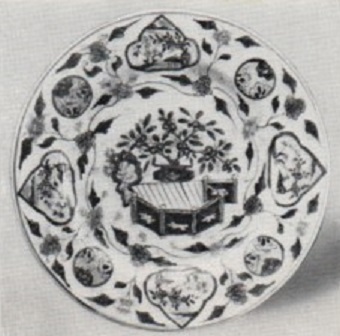
Reproduced from: Chinese export porcelain. Chine de Commande, (D.F. Lunsingh Scheurleer, London 1974), cat. 316. This dish is not included in this sale/offer. (copyright in bibliographic data and images is held by the publisher or by their respective licensors: all rights reserved)
Four identically shaped, sized and decorated dishes are in the collection of Augustus the Strong in Dresden and registered under the number P.O. (Porzellan Ostasien) 5699, 5735, 5738 and 5779. For these dishes, please see;
- SKD Online collection, PO. 5699.
- SKD Online collection, PO. 5735.
- SKD Online collection, PO. 5738.
- SKD Online collection, PO. 5779.
For other identically shaped, sized and decorated dishes, please see;
- Chine de Commande, (D.F. Lunsingh Scheurleer, Hilversum, 1966), cat. 307.
- Chinese export porcelain. Chine de Commande, (D.F. Lunsingh Scheurleer, London 1974), cat. 316.
Condition: Overall fine crazing to the glaze. A firing flaw to the inner footring and a filled chip to the reverse rim.
References:
Lunsingh Scheurleer 1966, cat. 307
Lunsingh Scheurleer 1974, cat. 316
SKD Online collection, PO. 5699
SKD Online collection, PO. 5735
SKD Online collection, PO. 5738
SKD Online collection, PO. 5779
Price: Sold.

Sold Ceramics - Sold Chinese Imari 1700-1800 - Flowers, Animals and Long Elizas - Page 3
Object 2012366
Dish
China
c.1710-1725
Height 33 mm (1.30 inch), diameter of rim 210 mm (8.27 inch), diameter of footring 115 mm (4.53 inch), weight 356 grams (12.56 ounce (oz.))
Dish on footring the sides with twelve impressed lotus-petal panels, the rim scalloped. Chinese Imari, decorated in underglaze blue, iron-red, black enamel and gold on the glaze with two ladies in a garden landscape near a fence with flowering plants a tree and pierced rockwork. On the sides twelve moulded lotus-petal panels filled with flowering plants alternating with flowerpots filled with flowering plants. Along the rim a diaper pattern with a single flower head. The reverse is undecorated.
Romance of the Western Chamber
The love story' Romance of the Western Chamber' (Xixiang ji) ranks among the most famous literary works of China. Its importance for young people can be compared to that of Shakespeare's 'Romeo and Juliet' in the West. 'Romance of the Western Chamber' was written by Wang Shifu (1260-1336). There already existed a short story in the Tang dynasty titled 'Biography of Yingying' (Yingying Zhuan) by Yuan Zhen (779-831), but Wang Shifu adapted it by adding details and giving it a happy rather than a sad ending. It tells the story of a forbidden love affair between the civil servant Zhang Sheng, who is gifted, but of a poor family background, and the pretty Cui Yingying, daughter of the Prime Minister. The two young people have their first encounter in a Buddhist temple, where Yingying and her mother have taken lodgings when accompanying the coffin of the recently deceased father back home. Suddenly, the temple is besieged by a local gang of outlaws, who demand the daughter to be handed over. Yingying's mother promises her daughter's hand in marriage to whoever saves the daughter from falling into the hands of the gang leader. However, when Zhang succeeds in doing so with the help of General Du, his childhood friend, she does not keep her promise. The young couple start a secret affair, supported by Hongniang ('Lady in Red'), Yingying's maid. When Yingying's mother discovers the affair, she consents to the marriage on the condition that Zhang passes the final examination for the highest position in the civil service of the capital, Zhang does so well, that he is granted a top position. (Suebsman 2019, p.43)
On this dish we see the two characters Yingying and Hongniang admiring flowers in the gardens of Pujiu Monastery. The student Zhang is about to see Yingying for the first time and fall in love with her. (Düsseldorf 2015, cat. 123.1 & Suebsman 2019, p.44)
For an identically, shaped, sized and decorated dish in a private North German collection, please see:
The design with the twelve impressed lotus-petal panels can also be found on on Chinese dishes, decorated in famille verte enamels from the period 171-1725, with the arms of Dutch cities and provinces. For examples of these type of dishes please see:
- Chinese Ceramics in the Collection of the Rijksmuseum Amsterdam. The Ming and Qing Dynasties, (C.J.A. Jörg in collaboration with J. van Campen, Rijksmuseum Amsterdam, London 1997), p.317, cat. 378.
- Famille Verte, Chinese Porcelain in Green Enamels, (C.J.A. Jörg, Schoten, 2011), p.170, cat. 160.
Condition: Some firing flaws, caused by the firing process to the reverse, some wear to the decoration and some glaze rough spots to the rim.
References:
Jörg & Van Campen 1997, cat. 378
Price: Sold.

Sold Ceramics - Sold Chinese Imari 1700-1800 - Flowers, Animals and Long Elizas - Page 3
Object 2011538
Dish
China
1720-1730
Height 32 mm (1.26 inch), diameter of rim 222 mm (8.74 inch), diameter of footring 110 mm (4.33 inch), weight 368 grams (12.98 ounce (oz.))
Dish on footring, flat underglaze brown-edged rim (jia mangkou). Chinese Imari, decorated in underglaze blue, overglaze iron-red, green and black enamel and gold with a half-open scroll showing flowering chrysanthemum, a pheasant in flight and a pheasant nesting on the branch of a prunus tree. The scroll is outlined by rather pronounced Japanese foliate and floral scrolls with chrysanthemum flowerheads. On the reverse two flowering sprays.
Chinese Imari was first introduced in the early years of the 18th century as an imitation of Japanese 'Imari'. It was based on a simpler form and was essentially an export type. The Chinese did not imitate the Japanese Imari models but copied the designs like kiku (chrysanthemum), roundels and half-roundels, fan-shaped panels, partly unrolled bamboo blinds and rather pronounced foliate and floral scrolls. The Japanese Imari colour combination was also copied, the Chinese Imari colour palette consisted of iron-red enamel and gold in combination with underglaze blue. Sometimes other colours, and even certain enamels of the famille verte such as green and black, were sparingly introduced and used in a subtle way. Chinese Imari remained popular into the 1720 after which it became overshadowed by opaque enamels. (Howard & Ayers 1978, vol. 1, p.137), (Jörg & Van Campen 1997, p.199), (Sargent 2012, pp.183-188)
On this Chinese Imari dish the half-open scroll and the pronounced foliate and floral scrolls are clearly Japanese design elements copied by the Chinese who in this way tried to appeal to their newly re-established European market. Similar dishes were collected by August the Strong, elector of Saxony and King of Poland, and were also copied by the Meissen porcelain factory around 1760. (Sargent 2012, p.188)
All known published versions of this design show one magpie perched on the branch of a prunus with bamboo. Interestingly this particular dish shows two phoenixes and chrysanthemum.
For identically decorated dishes, please see:
- China for the West. Chinese Porcelain and other Decorative Arts for Export illustrated from the Mottahedeh Collection, (D.S. Howard & J. Ayers, Philip Wilson Publishers for Sotheby Parke Bernet Publications, London 1978), vol. 1, p.139, cat. 118.
- Early Japanese Porcelain: Arita Porcelain in the Dresden Collection, (F. Reichel, Londen 1981), p.133, cat. 89.
- Important Chinese Export Porcelain from the Mottahedeh Collection, (Sotheby's, New York, Wednesday, January 30, 1985), lot 70.
- Chinese Export Porcelain in the Reeves Center Collection at Washington and Lee University, (Th. V. Litzenburg, London 2003), p.78, cat. 62.
- Treasures of Chinese Export Ceramics from the Peabody Essex Museum, (W.R. Sargent, Salem, Massachusetts, 2012), p.188, plate 87.
- Royal Collection Trust - Works of Art - RCIN 6435
Condition: A frit to the rim.
References:
Howard & Ayers 1978, vol. 1, cat. 118
Price: Sold.
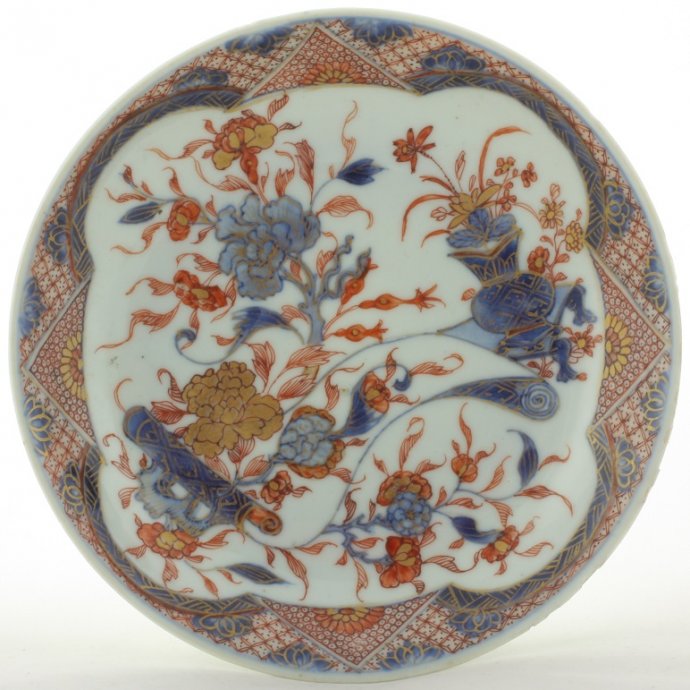
Sold Ceramics - Sold Chinese Imari 1700-1800 - Flowers, Animals and Long Elizas - Page 3
Object 2011414
Small dish
China
1720-1735
Height 28 mm (1.10 inch), diameter of rim 161 mm (6.34 inch), diameter of footring 95 mm (3.74 inch), weight 147 grams (5.19 ounce (oz.))
Small dish on a footring with a straight rim. Chinese Imari, decorated in underglaze blue, overglaze iron-red and gold with an open scroll showing flowering peonies and a vase on a low table filled with flowering plant. On the sides and rim a trellis pattern border with half flower heads and triangular panels filled with a whorl pattern and half flower heads and looped bows with a zig-zag pattern in gold. The reverse is undecorated.
Condition: Some glaze rough spots to the rim.
Price: Sold.
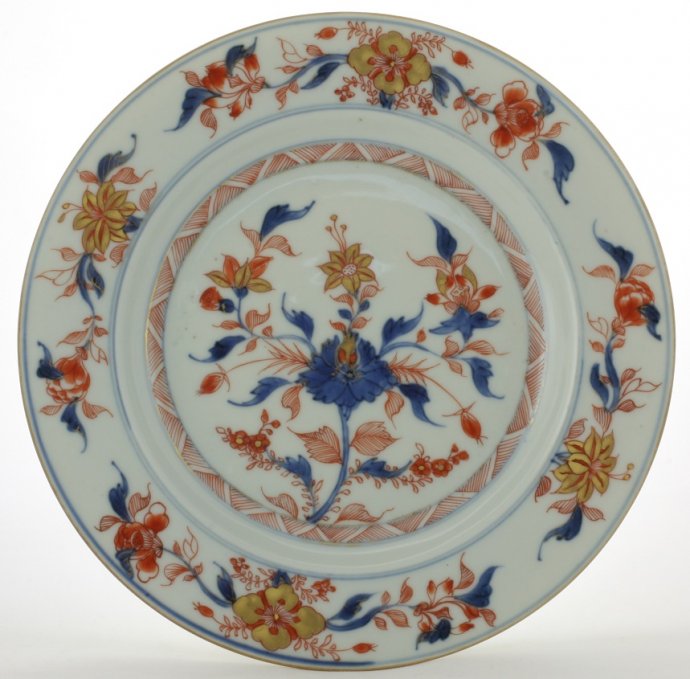
Sold Ceramics - Sold Chinese Imari 1700-1800 - Flowers, Animals and Long Elizas - Page 3
Object 2010464
Dish
China
1710-1720
Height 24 mm (0.95 inch), diameter of rim 216 mm (8.50 inch), diameter of footring 115 mm (4.53 inch)
Dish on footring, flat rim. Chinese Imari, decorated in underglaze blue, overglaze iron-red and gold with various flowering plants. On the sides a zig-zag-lines pattern border and on the rim four flowering sprays. On the reverse two flower sprays.
Condition: Perfect.
Price: Sold.
More pictures >>

Sold Ceramics - Sold Chinese Imari 1700-1800 - Flowers, Animals and Long Elizas - Page 3
Object 2010162
Dish
China
1720-1740
Provenance: Fa. A.C. Beeling & Zn, Hofleverancier (seller to The Dutch Royal House), Leeuwarden, the Netherlands.
Height 29 mm (1.14 inch), diameter of rim 227 mm (8.94 inch), diameter of footring 125 mm (4.92 inch)
Dish on footring, flat underglaze brown-edged rim (jia mangkou). Chinese Imari, decorated in underglaze blue, overglaze iron-red and gold with flowering peony branches. On the sides trellis pattern border filled with four flowering chrysanthemums and four reserves filled with antiquities. On the rim four flower sprays, two with antiquities. On the reverse three flower sprays.
The dish used to have, as proof of quality and provenance, a paper Chien-Lung (1736-1796) period label of A.C. Beeling & Zoon B.V. Hofleverancier (seller to The Dutch Royal House), Leeuwarden on its base. Tthis label was removed by the previous owner from whom I bought the dish. The pictures of the dish with the Beeling & Zoon B.V. label still on the dish were made and given to me by the the previous owner of the dish. (The business card of Mr. A.C. Beeling is not included in this offer).
Condition: Perfect.
Reference:
Price: Sold.
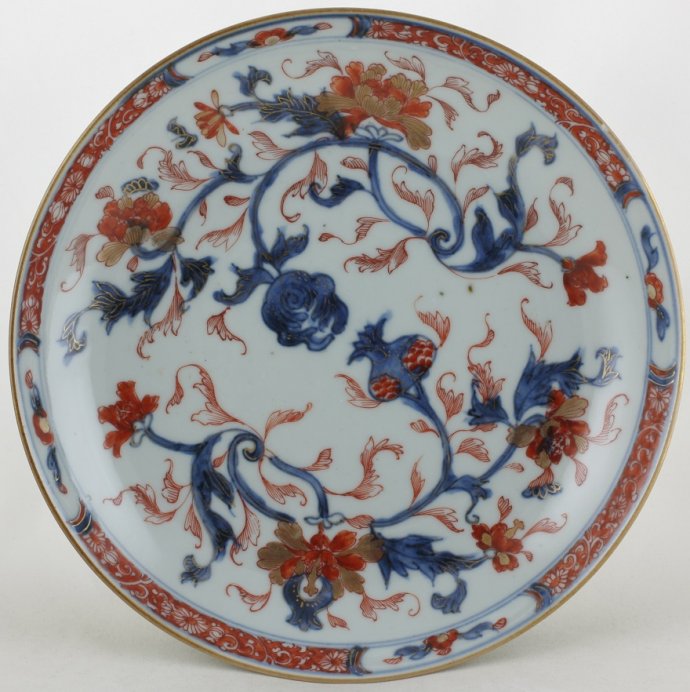
Sold Ceramics - Sold Chinese Imari 1700-1800 - Flowers, Animals and Long Elizas - Page 3
Object 2011502
Dish
China
1720-1740
Height 35 mm (1.38 inch), diameter of rim 217 mm (8.54 inch), diameter of footring 135 mm (5.31 inch), weight 384 grams (13.54 ounce (oz.))
Dish on footring, straight underglaze brown-edged rim (jia mangkou). Chinese Imari, decorated in underglaze blue, overglaze iron-red and gold with a two peony sprays one with pomegranate the other with finger-lemon fruit also called 'Buddha's-hand citron' (Citrus medica). On the rim four reserves filled with florets between scrolls on a iron-red ground with flower heads and leafy scrolls in reverse decoration. The reverse is undecorated.
Fingered citron or Buddha's hand (Citrus medica) (images courtesy of S. Fan)
Condition: A firing flaw to the footring and a flebiate to the rim.
Price: Sold.
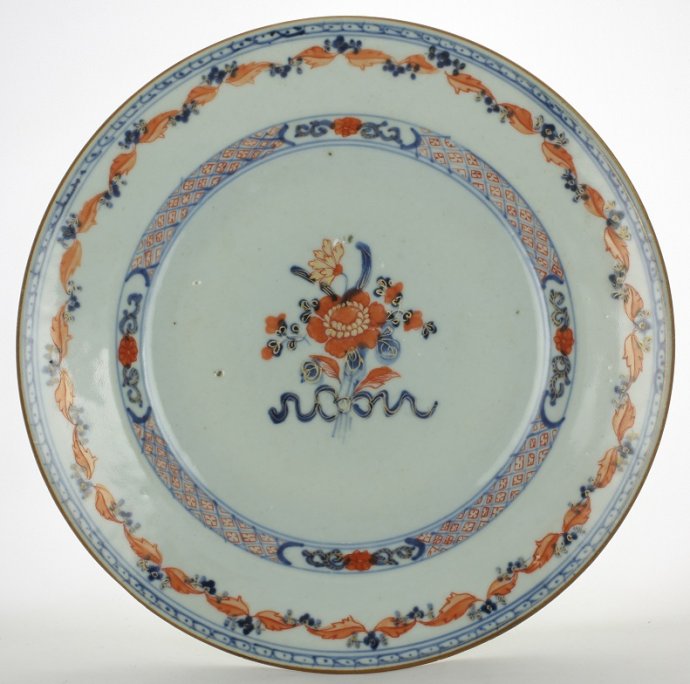
Sold Ceramics - Sold Chinese Imari 1700-1800 - Flowers, Animals and Long Elizas - Page 3
Object 2010642
Dish
China
1730-1750
Height 27 mm (1.06 inch), diameter of rim 232 mm (9.13 inch), diameter of footring 130 mm (4.72 inch)
Dish on footring, flat underglaze brown-edged rim (jia mangkou). On the base a single spur-mark. Chinese Imari, decorated in underglaze blue, overglaze iron-red and gold with a flowering chrysanthemum and peony branches tied together with tassels. On the sides a trellis pattern border with four reserves filled with florets between scrolls. On the rim a continuous scroll of leaves with flower heads and a spiral pattern border. The reverse is undecorated.
Spur-marks are a rare features on Chinese export porcelain.
Condition: Firing flaws to the rim and base and two tiny fleabites to the rim.
Reference:
Price: Sold.
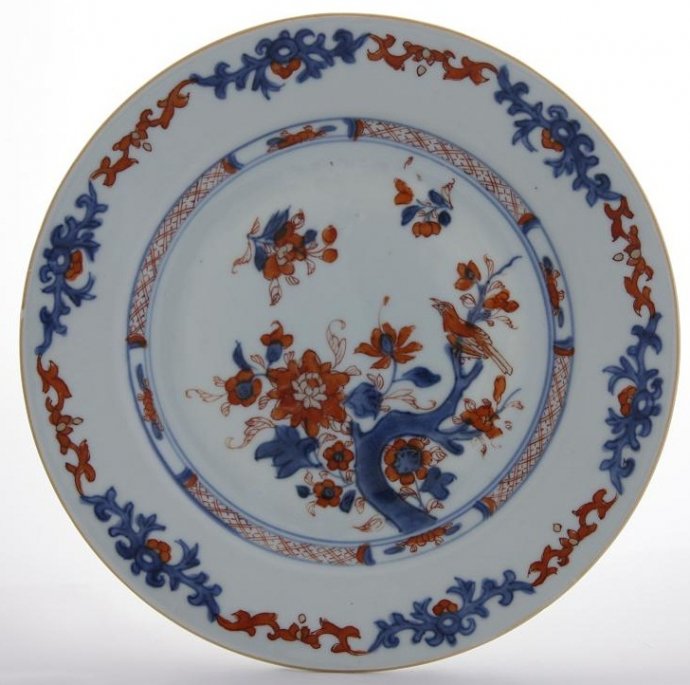
Sold Ceramics - Sold Chinese Imari 1700-1800 - Flowers, Animals and Long Elizas - Page 3
Object 2010154
Dish
China
1730-1750
Height 25 mm (0.98 inch), diameter of rim 228 mm (8.98 inch), diameter of footring 130 mm (5.12 inch)
Dish on footring, flat rim. Chinese Imari, decorated in underglaze blue, overglaze iron-red and gold with a flowering peony and a bird perched on a branch. On the sides a diaper pattern border with four reserves filled with flowers. On the rim a scroll of flowering branches. The reverse is undecorated.
The floral scroll border on the rim suggest an European design as a source of inspiration for the decoration on this dish.
Condition: Perfect.
Price: Sold.
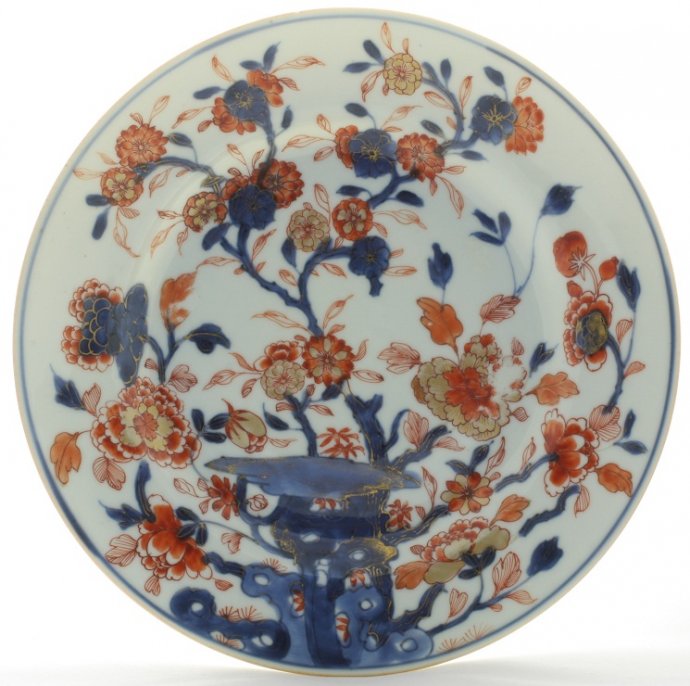
Sold Ceramics - Sold Chinese Imari 1700-1800 - Flowers, Animals and Long Elizas - Page 3
Object 2010117
Dish
China
1730-1750
Height 27 mm (1.06 inch), diameter of rim 224 mm (8.82 inch), diameter of footring 110 mm (4.33 inch)
Dish on footring, flat underglaze brown-edged rim (jia mangkou). Chinese Imari, overall decorated in underglaze blue, overglaze iron-red and gold with a flowering peony tree growing from a taihu rock. The reverse is undecorated.
By covering the whole service (using the sides and rim as part of the overall design) the porcelain decorator used a new decorating technique letting go of the old standard ways and patterns of decorating dishes.
Condition: A tiny firing flaw to the reverse rim.
Reference:
Price: Sold.

Sold Ceramics - Sold Chinese Imari 1700-1800 - Flowers, Animals and Long Elizas - Page 3
Object 2010566
Cream dish
China
1740-1750
Height 33 mm (1.30 inch), diameter of rim 165 mm (6.50 inch), diameter of footring 88 mm (3.46 inch), weight 153 grams (5.40 ounce (oz.))
Cream dish on footring, flat underglaze brown-edged rim (jia mangkou). Chinese Imari, decorated in underglaze blue, overglaze iron-red and gold with flowering chrysanthemum and peony plants growing from pierced rockwork and a single pheasant standing on top of the pierced rockwork. Around the inner rim a scroll of foliage and flowering peony heads. The reverse is undecorated.
The pheasant on a rock is a very popular motif on export porcelain and frequently appears on enamelled and underglaze blue Kangxi wares. According to Williams, in the Chinese bureaucratic hierarchy officials of the second grade had a gold pheasant embroidered on their court robes, those of the fifth grade a silver pheasant. The bird was represented as standing on a rock, looking towards the sun, the imperial symbol of authority. (Williams 1976, pp.322-323), (Jörg & Van Campen 1997, p.157)
Condition: A firing flaw to the rim and a glaze hairline to base only visible on the reverse side.
References:
Jörg & Van Campen 1997, cat. 171
Price: Sold.


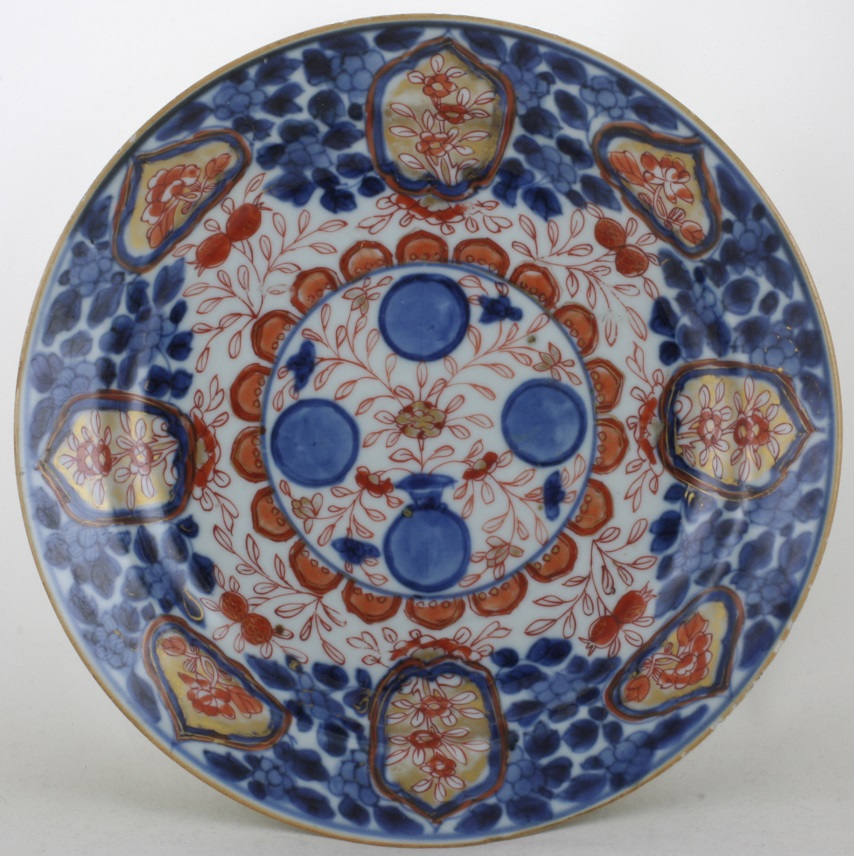
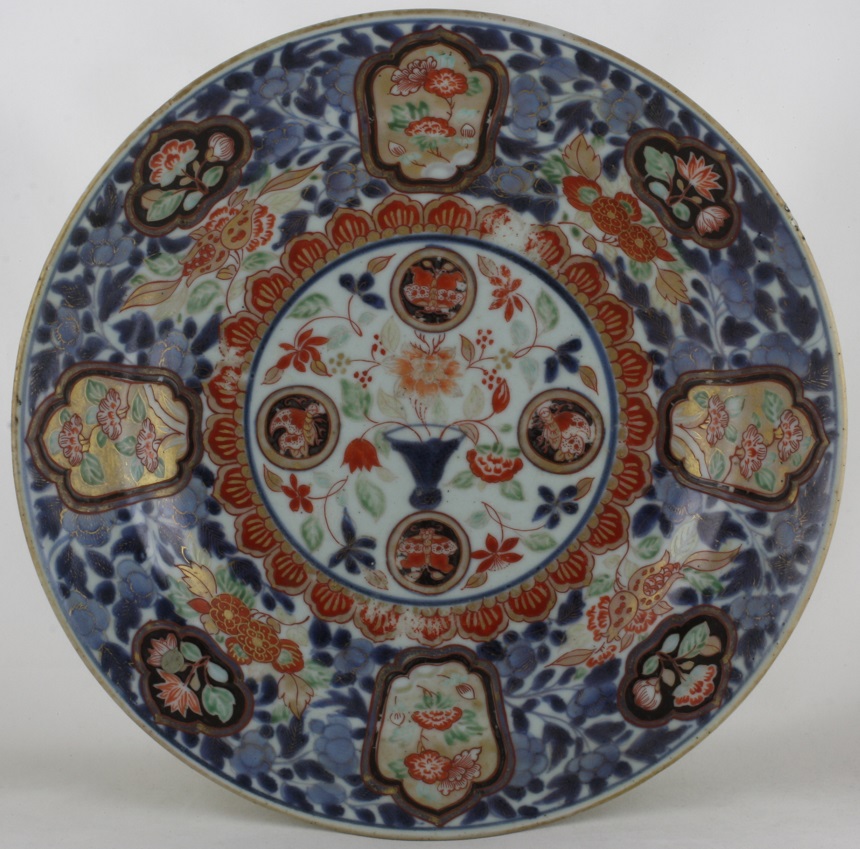

.jpg)
 create websites
create websites